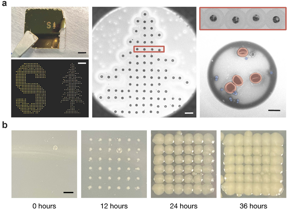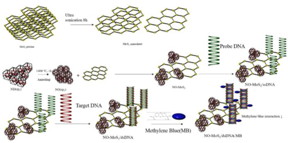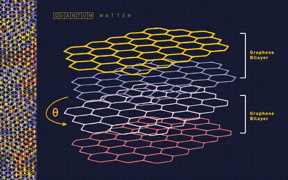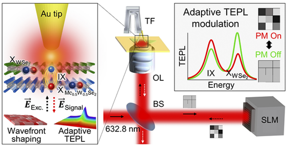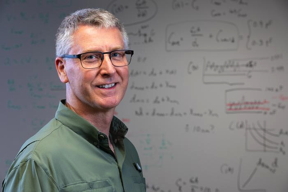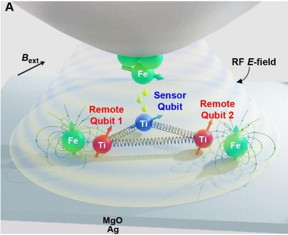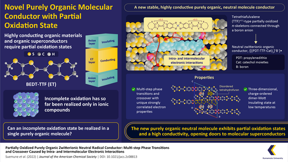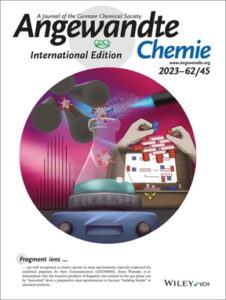Home > Press > Successful morphing of inorganic perovskites without damaging their functional properties
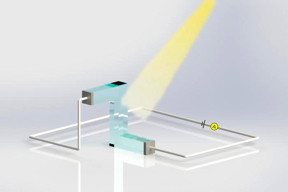 |
| Applying morphed perovskites to construct an innovative photodetector. CREDIT ©Dr Li Xiaocui / City University of Hong Kong |
Abstract:
A research team co-led by scholars from City University of Hong Kong (CityU) has successfully morphed all-inorganic perovskites at room temperature without compromising their functional properties. Their findings demonstrate the potential of this class of semiconductors for manufacturing next-generation deformable electronics and energy systems in the future.
Successful morphing of inorganic perovskites without damaging their functional properties
Hong Kong, China | Posted on October 6th, 2023
All-inorganic lead halide perovskites are becoming increasingly important semiconducting materials in energy conversion and optoelectronics because of their outstanding performance and enhanced environmental stability.
“However, unlike metal materials or polymers, inorganic semiconductors are often brittle and hard to process. This strongly restricts their applications as optoelectronic products that must withstand mechanical stress and strain without losing their functionality,” said Professor Chen Fu-Rong, Associate Vice-President (Mainland Collaboration) and Chair Professor of Materials Science at CityU, who co-led the study.
To overcome this limitation, a research team led by Professor Chen, along with Professor Johnny Ho Chung-yin, Associate Head and Professor in the Department of Materials Science and Engineering (MSE), Professor Zhao Shijun, in the Department of Mechanical Engineering (MNE) at CityU, and Professor Lu Yang, former professor in MNE and currently working at The University of Hong Kong (HKU), explored the deformability of all-inorganic perovskites (CsPbX3, where X can be Cl, Br or I ions). They found perovskites can be substantially morphed into distinct geometries at room temperature while preserving their functional properties, an achievement unprecedented in conventional inorganic semiconductors.
In their experiments, the team first synthesized single-crystal micropillars of CsPbX3 with diameters and widths ranging from 0.4 to 2 μm and lengths of 3 to 10 μm, using the vapour-liquid-solid method. They then conducted in situ compression experiments with a scanning electron microscope.
They found that under compression, there were continuous slips of partial dislocations on multiple slip systems in the CsPbX3 crystal lattice. This ‘domino-like’ multi-slipping deformation mechanism enabled the micropillars to deform into various distinct shapes without fracturing, including upside-down L shape, Z shape, and wine-glass shape.
With the aid of an atomic-resolution transmission electron microscope (TEM), the team revealed that the atoms in the deformation zone were well connected, leading to undamaged functional properties. “We also observed that the optoelectronic performance of the micropillars remained unaffected by the deformation,” said Professor Ho. “This demonstrates the potential of these materials for use in deformable optoelectronics.”
The research team performed further electronic and structural analyses to uncover the physical origin of this unusual behaviour. “The secret of the morphing ability is the low-slip energy barrier, which ensures facile slips, and the strong Pb–X bonds, which maintain the crystal’s structural integrity and prevent cracking or cleaving,” said Professor Zhao Shijun, who specializes in the properties of computational materials. And the bandgap – an energy index influencing the total electrical properties of intrinsic semiconductors – of the CsPbX3 crystal lattice remained unchanged after deformation, indicating that the electronic structure of the material was unaffected, he added.
“Our results demonstrated that all-inorganic CsPbX3 single crystals can be substantially deformed and facilely morphed into various shapes through multi-slipping under ambient conditions, without changing their crystalline integrity, lattice structure or optoelectronic properties,” said Professor Chen.
“This achievement represents a significant step towards designing and manufacturing innovative energy devices and deformable electronics. The underlying mechanism, uncovered by a TEM at the atomic level provides important implications for seeking other intrinsic ductile semiconductors,” he added.
The findings were published in Nature Materials under the title “Multislip-enabled morphing of all-inorganic perovskites”.
The first authors are Dr Li Xiaocui, Dr Meng You and Dr Li Wanpeng, postdocs in the MSE Department. The corresponding authors are Professor Chen, Professor Ho, Professor Zhao, and Professor Lu of HKU. Other collaborators are researchers from CityU and Zhejiang University.
The research is supported by the Hong Kong Research Grants Council (RGC), CityU, and the National Natural Science Foundation of China/RGC Hong Kong Joint Research Scheme.
####
For more information, please click here
Contacts:
P.K. Lee
City University of Hong Kong
Office: 852-344-28925
Copyright © City University of Hong Kong
If you have a comment, please Contact us.
Issuers of news releases, not 7th Wave, Inc. or Nanotechnology Now, are solely responsible for the accuracy of the content.
| Related Links |
| Related News Press |
News and information
![]() Observation of left and right at nanoscale with optical force October 6th, 2023
Observation of left and right at nanoscale with optical force October 6th, 2023
![]() The efficient perovskite cells with a structured anti-reflective layer – another step towards commercialization on a wider scale October 6th, 2023
The efficient perovskite cells with a structured anti-reflective layer – another step towards commercialization on a wider scale October 6th, 2023
![]() Super-efficient laser light-induced detection of cancer cell-derived nanoparticles: Skipping ultracentrifugation, detection time reduced from hours to minutes! October 6th, 2023
Super-efficient laser light-induced detection of cancer cell-derived nanoparticles: Skipping ultracentrifugation, detection time reduced from hours to minutes! October 6th, 2023
![]() Interdisciplinary: Rice team tackles the future of semiconductors Multiferroics could be the key to ultralow-energy computing October 6th, 2023
Interdisciplinary: Rice team tackles the future of semiconductors Multiferroics could be the key to ultralow-energy computing October 6th, 2023
Perovskites
![]() The efficient perovskite cells with a structured anti-reflective layer – another step towards commercialization on a wider scale October 6th, 2023
The efficient perovskite cells with a structured anti-reflective layer – another step towards commercialization on a wider scale October 6th, 2023
![]() Novel design perovskite electrochemical cell for light-emission and light-detection May 12th, 2023
Novel design perovskite electrochemical cell for light-emission and light-detection May 12th, 2023
Possible Futures
![]() Discovery made by University of Warsaw scientists may enable network interface for quantum computers October 6th, 2023
Discovery made by University of Warsaw scientists may enable network interface for quantum computers October 6th, 2023
![]() The medicine of the future could be artificial life forms October 6th, 2023
The medicine of the future could be artificial life forms October 6th, 2023
![]() Interdisciplinary: Rice team tackles the future of semiconductors Multiferroics could be the key to ultralow-energy computing October 6th, 2023
Interdisciplinary: Rice team tackles the future of semiconductors Multiferroics could be the key to ultralow-energy computing October 6th, 2023
Chip Technology
![]() A new qubit platform is created atom by atom October 6th, 2023
A new qubit platform is created atom by atom October 6th, 2023
![]() Twisted science: NIST researchers find a new quantum ruler to explore exotic matter October 6th, 2023
Twisted science: NIST researchers find a new quantum ruler to explore exotic matter October 6th, 2023
![]() Interdisciplinary: Rice team tackles the future of semiconductors Multiferroics could be the key to ultralow-energy computing October 6th, 2023
Interdisciplinary: Rice team tackles the future of semiconductors Multiferroics could be the key to ultralow-energy computing October 6th, 2023
Optical computing/Photonic computing
![]() University of Chicago scientists invent smallest known way to guide light: 2D optical waveguides could point way to new technology August 11th, 2023
University of Chicago scientists invent smallest known way to guide light: 2D optical waveguides could point way to new technology August 11th, 2023
![]() USTC enhances fluorescence brightness of single silicon carbide spin color centers June 9th, 2023
USTC enhances fluorescence brightness of single silicon carbide spin color centers June 9th, 2023
Discoveries
![]() Super-efficient laser light-induced detection of cancer cell-derived nanoparticles: Skipping ultracentrifugation, detection time reduced from hours to minutes! October 6th, 2023
Super-efficient laser light-induced detection of cancer cell-derived nanoparticles: Skipping ultracentrifugation, detection time reduced from hours to minutes! October 6th, 2023
![]() A new qubit platform is created atom by atom October 6th, 2023
A new qubit platform is created atom by atom October 6th, 2023
![]() Twisted science: NIST researchers find a new quantum ruler to explore exotic matter October 6th, 2023
Twisted science: NIST researchers find a new quantum ruler to explore exotic matter October 6th, 2023
![]() Discovery made by University of Warsaw scientists may enable network interface for quantum computers October 6th, 2023
Discovery made by University of Warsaw scientists may enable network interface for quantum computers October 6th, 2023
Announcements
![]() Observation of left and right at nanoscale with optical force October 6th, 2023
Observation of left and right at nanoscale with optical force October 6th, 2023
![]() The efficient perovskite cells with a structured anti-reflective layer – another step towards commercialization on a wider scale October 6th, 2023
The efficient perovskite cells with a structured anti-reflective layer – another step towards commercialization on a wider scale October 6th, 2023
![]() Super-efficient laser light-induced detection of cancer cell-derived nanoparticles: Skipping ultracentrifugation, detection time reduced from hours to minutes! October 6th, 2023
Super-efficient laser light-induced detection of cancer cell-derived nanoparticles: Skipping ultracentrifugation, detection time reduced from hours to minutes! October 6th, 2023
![]() A new qubit platform is created atom by atom October 6th, 2023
A new qubit platform is created atom by atom October 6th, 2023
Interviews/Book Reviews/Essays/Reports/Podcasts/Journals/White papers/Posters
![]() Observation of left and right at nanoscale with optical force October 6th, 2023
Observation of left and right at nanoscale with optical force October 6th, 2023
![]() The efficient perovskite cells with a structured anti-reflective layer – another step towards commercialization on a wider scale October 6th, 2023
The efficient perovskite cells with a structured anti-reflective layer – another step towards commercialization on a wider scale October 6th, 2023
![]() Super-efficient laser light-induced detection of cancer cell-derived nanoparticles: Skipping ultracentrifugation, detection time reduced from hours to minutes! October 6th, 2023
Super-efficient laser light-induced detection of cancer cell-derived nanoparticles: Skipping ultracentrifugation, detection time reduced from hours to minutes! October 6th, 2023
![]() A new qubit platform is created atom by atom October 6th, 2023
A new qubit platform is created atom by atom October 6th, 2023
Energy
![]() The efficient perovskite cells with a structured anti-reflective layer – another step towards commercialization on a wider scale October 6th, 2023
The efficient perovskite cells with a structured anti-reflective layer – another step towards commercialization on a wider scale October 6th, 2023
![]() A non-covalent bonding experience: Scientists discover new structures for unique hybrid materials by altering their chemical bonds July 21st, 2023
A non-covalent bonding experience: Scientists discover new structures for unique hybrid materials by altering their chemical bonds July 21st, 2023
![]() Graphene-based Carbocatalysts: Synthesis, Properties, and Applications—Beyond Boundaries June 9th, 2023
Graphene-based Carbocatalysts: Synthesis, Properties, and Applications—Beyond Boundaries June 9th, 2023
![]() When all details matter — Heat transport in energy materials June 9th, 2023
When all details matter — Heat transport in energy materials June 9th, 2023
- SEO Powered Content & PR Distribution. Get Amplified Today.
- PlatoData.Network Vertical Generative Ai. Empower Yourself. Access Here.
- PlatoAiStream. Web3 Intelligence. Knowledge Amplified. Access Here.
- PlatoESG. Carbon, CleanTech, Energy, Environment, Solar, Waste Management. Access Here.
- PlatoHealth. Biotech and Clinical Trials Intelligence. Access Here.
- Source: http://www.nanotech-now.com/news.cgi?story_id=57397
- :has
- :is
- :not
- :where
- 10
- 12th
- 21st
- 26
- 2D
- 30th
- 6th
- 7th
- 8th
- 9th
- a
- ability
- accuracy
- achievement
- added
- adverse
- After
- Aid
- All
- along
- also
- Ambient
- Ambient Conditions
- an
- analyses
- and
- Another
- Application
- applications
- Applying
- ARE
- artificial
- AS
- Associate
- At
- atom
- AUGUST
- authors
- barrier
- BE
- because
- becoming
- Bonds
- by
- CAN
- Cancer
- cell
- Cells
- Center
- CGI
- Chair
- changing
- chemical
- chen
- chicago
- China
- chip
- City
- class
- click
- collaboration
- color
- COM
- comment
- commercialization
- Complement
- complex
- compromising
- computational
- conditions
- conducted
- connected
- construct
- content
- continuous
- conventional
- Conversion
- Corresponding
- could
- Council
- cracking
- created
- credit
- Crystal
- Currently
- damaging
- demonstrate
- demonstrated
- demonstrates
- Department
- Design
- designing
- details
- Detection
- develop
- Devices
- diagnosis
- dimensions
- discover
- distinct
- dna
- dr
- Early
- Edge
- effects
- efficient
- Electronic
- Electronics
- enable
- enabled
- end
- energy
- Engineering
- enhanced
- Enhances
- ensures
- environmental
- Ether (ETH)
- Exotic
- experience
- experiments
- Explain
- explore
- Explored
- fewer
- Find
- findings
- First
- For
- Former
- found
- Foundation
- fracturing
- from
- functional
- functionality
- further
- future
- gif
- grants
- guide
- Hard
- Have
- he
- head
- help
- High
- Hong
- Hong Kong
- hong kong research
- HOURS
- http
- HTTPS
- human
- Hybrid
- i
- if
- implications
- important
- in
- Inc.
- Including
- increasingly
- index
- indicating
- influencing
- information
- innovative
- integrity
- Interface
- into
- intrinsic
- Johnny
- joint
- jpg
- July
- june
- Key
- known
- Kong
- laser
- layer
- lead
- leading
- Led
- left
- Level
- li
- Life
- light
- limitation
- links
- losing
- made
- mainland
- maintain
- make
- manufacturing
- material
- materials
- Matter
- May..
- mechanical
- mechanical engineering
- mechanism
- medicine
- metal
- method
- Microscope
- more
- multiple
- must
- nanotechnology
- National
- Natural
- Nature
- net
- network
- New
- news
- next-generation
- nist
- Noise
- novel
- now
- observed
- october
- of
- often
- on
- or
- Origin
- Other
- outstanding
- Overcome
- performance
- performed
- PHP
- physical
- platform
- plato
- Plato Data Intelligence
- PlatoData
- please
- Point
- Polymers
- Post
- posted
- potential
- preserving
- press
- Press Release
- prevent
- process
- Products
- Professor
- promising
- properties
- provides
- published
- Quantum
- Qubit
- random
- ranging
- reactions
- reduce
- Reduced
- release
- Releases
- remained
- represents
- research
- researchers
- responsible
- Results
- return
- Revealed
- Rice
- right
- Room
- safer
- Said
- Save
- scalable
- scanning
- scheme
- Scholars
- Science
- scientists
- Search
- Secret
- seeking
- Semiconductors
- September
- Shape
- shapes
- Share
- Shows
- side
- significant
- Silicon
- silicon carbide
- single
- solely
- specializes
- Spin
- Stability
- start
- Step
- Strategy
- stress
- strong
- strongly
- structural
- structure
- structured
- structures
- Study
- submit
- substantially
- successful
- Successfully
- Supported
- synthetic
- system
- Systems
- Tackles
- team
- that
- The
- The Future
- their
- then
- There.
- These
- they
- this
- Through
- time
- Title
- to
- Total
- toward
- towards
- transport
- unaffected
- uncover
- uncovered
- under
- underlying
- unique
- university
- unlike
- unprecedented
- unusual
- unwanted
- us
- use
- used
- using
- various
- Voltage
- Warsaw
- was
- Wave
- Way..
- WELL
- were
- which
- while
- WHO
- wider
- with
- without
- working
- X
- Yahoo
- you
- zephyrnet
- Zhao











